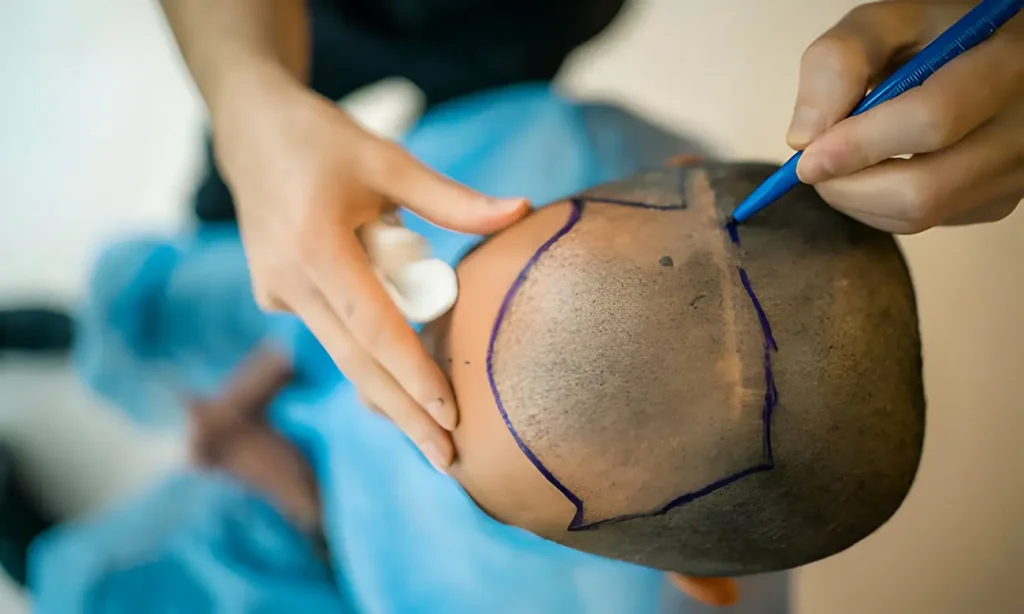Type and hit Enter to search
Experts in aesthetic surgery, dermatology, and beauty bring you the latest trends, research, and advice to help you make informed decisions about your appearance and health.
A web platform dedicated to aesthetic surgery, dermatology, and beauty, where expertise meets innovation, and your desires and needs become our mission. In a world where appearance and health go hand in hand, our platform leads the revolution, delivering the latest trends, research, and expert advice directly to you.
Our team consists of highly skilled professionals in the fields of aesthetic surgery and dermatology, committed to providing reliable information and guidance that will help you make informed choices about your appearance and well-being. We understand that every individual has unique needs and desires, which is why we approach each person with the utmost care and professionalism.
Powered by Aestetica Web Design © 2024
When Follicles Fail: Common Problems After Hair Transplantation and Their Solutions
Hair transplantation promises to restore your scalp, but the path to lush hair isn't always smooth. Dive into the world of follicles with us and learn how to overcome problems after transplantation.
Hair, that wondrous material that grows from our heads, has always been much more than mere decoration. It was and remains a reflection of our identity, status, and even political beliefs. Just remember the lavish wigs of French nobles in the 18th century, which were a symbol of wealth and power. Or the rebellious hairstyles of punks in the 70s, which were a cry against the establishment. Today, in the age of Instagram and TikTok, hair has become a canvas for self-expression, and celebrity hairstyles like Hollywood curls often dictate trends worldwide.
Hair Transplantation: Magic Wand or Science Fiction?
In a world where there seems to be a solution for everything, from wrinkles to cellulite, hair transplantation is often seen as a magic wand that will solve all hair loss problems. But is it really so? Although hair transplantation has progressed at an incredible pace, it’s important to break down the myths and understand that it’s not a magical overnight solution. Just as Harry Potter couldn’t solve all problems with a wave of his magic wand, neither is hair transplantation a magic cure for everything. It is a medical procedure that requires time, patience, and realistic expectations.
The Life Cycle of Hair: From Birth to (Possible) Rebirth
The life cycle of hair is like an exciting soap opera, full of drama, intrigue, and unexpected twists. It all starts with the birth of the follicle, a tiny sac from which the hair grows. Then follows the growth phase, when the hair proudly grows towards the sun. But, like everything in life, hair has its expiration date. After the growth phase follows the resting phase, and then the shedding phase, when the hair leaves its comfortable nest. But the story doesn’t have to end there. Hair transplantation allows for the “rebirth” of the follicle, giving it a second chance to grow.
Expectations vs. Reality: When Follicles Don’t Cooperate
After a hair transplant, many patients expect their hair to grow luxuriantly right away. However, the reality is often different. Follicles, like people, sometimes need time to adjust to a new environment. Shock loss can occur, where transplanted hairs fall out before they start growing again. Also, hair growth may be slower than expected, and the density may not be what patients envisioned. It’s important to have realistic expectations and understand that hair transplantation is a process, not a one-time event.
Zagreb Time Machine: A Historical Overview of Hair Transplantation in the Croatian Metropolis
Zagreb, like many other world capitals, has a rich history of hair transplantation. The first procedures were performed in the 1970s, when techniques were far less sophisticated than today. Over the years, Zagreb has become a center for hair transplantation in the region, attracting patients from all over the world. The development of new techniques, such as the FUE method, has enabled more natural and aesthetically pleasing results, and Zagreb’s experts have become known for their expertise and innovation.
Shock Loss: When New Hair Decides to Leave Before Settling In
Imagine that you’ve finally gathered the courage and decided on a hair transplant. After the procedure, full of hope and anticipation, you look at your new hair in the mirror, imagining how it will soon become thick and lush. But then something unexpected happens – the hair you’ve worked so hard and paid for starts falling out. It’s as if you’ve just moved into a new apartment, and on the first day your water heater breaks, a pipe leaks, and the neighbor’s dog starts howling at three in the morning. You feel disappointed, frustrated, and even cheated.
But before panic sets in, take a deep breath and remember that this is a completely normal occurrence. Shock loss, as experts call it, is a common side effect of hair transplantation and happens to most patients. It’s actually a sign that your follicles are adjusting to their new environment, much like a teenager rebels against authority during puberty.
What exactly is happening? During transplantation, follicles are removed from the donor area and transplanted to the area where hair is missing. This process is traumatic for them, as if they were uprooted from their comfortable home and thrown into an unknown environment. As a result, the follicles may react by rejecting the hair they have produced. This hair loss usually occurs within a few weeks after the procedure and can be quite dramatic, but don’t worry, it doesn’t mean the transplant was unsuccessful.
Shock loss is actually part of the healing and regeneration process. After the follicles recover from the shock, they will start producing hair again, but this time in a new place. This process can take several months, and even up to a year, but the end result will be thick and healthy hair.
It’s important to note that shock loss is not a cause for concern, but a normal phase in the hair transplant process. However, if you are concerned or have any questions, you can always contact your doctor for advice and support.
Slowed Growth: Patience is a Virtue, Especially for Follicles
After the initial shock of the transplant passes and the follicles settle down from their little rebellion, many patients eagerly await the moment when new hair will finally start to sprout. But as is well known, patience is a virtue, and this is especially true for follicles after transplantation.
Despite the desire for quick results, it’s important to understand that hair growth is a process that takes time. Follicles are like small plants that need time to take root, adapt to their new environment, and start to bloom. Imagine transplanting a flower into a new pot – you wouldn’t expect it to bloom immediately, right? Similarly, follicles need time to recover from the stress of transplantation and restart their growth cycle.
This process can be frustrating for patients, especially if they expected quick results. However, it’s important to have realistic expectations and understand that every organism is different, and therefore the speed of hair growth can vary from person to person.
For some, hair will start to sprout after a few months, while others will need up to a year to see significant results. In addition to individual factors, other factors can affect the speed of hair growth, such as age, health status, lifestyle, and postoperative care.
That’s why it’s crucial to follow your doctor’s instructions and adhere to the prescribed therapy. This may include taking medication, using special shampoos and lotions, and avoiding certain activities that can interfere with the healing and hair growth process.
Patience and consistency in care are key to achieving optimal results. In the meantime, don’t be discouraged if you don’t see results right away. Remember that each follicle is a small hair factory working at full speed, it just needs to be given time to show its magic.
Unsatisfactory Density: When Follicles Play Hide and Seek
Sometimes, despite a successful transplant, the density of the hair may not be what you expected. This can be due to various factors, such as the quality of the donor area, individual characteristics of the follicles, or even lifestyle. Just as some people are easier to hide in a game of hide and seek, some follicles can “hide” and not produce hair at the rate we would like. But there are solutions for this problem as well, such as additional treatments or correction of the transplant.
Infections and Inflammations: Unwanted Guests on the Scalp
Hair transplantation, although minimally invasive, is still a surgical procedure that in a certain way disrupts the natural barrier of the skin. The scalp, after undergoing the process of extracting and transplanting follicles, becomes temporarily more sensitive and susceptible to unwanted intruders – bacteria and other microorganisms that can cause infections and inflammations.
Imagine it as an open door to your house after you’ve invited friends to a party. While you’re enjoying the company, some uninvited guests may sneak in and start making a mess. Similarly, while hair transplantation is generally safe, there is a risk that bacteria will take the opportunity and settle on the weakened scalp.
Infections can manifest in different ways, from mild redness and itching to more serious conditions such as folliculitis (inflammation of the hair follicles) or even abscesses (pus-filled pockets). Inflammation, on the other hand, can cause pain, swelling, and tenderness of the scalp.
Fortunately, infections and inflammations after hair transplantation are not inevitable. Proper care and hygiene of the scalp are key to preventing these problems. This includes regular washing of the hair with a mild shampoo, avoiding touching the scalp with dirty hands, and following all instructions given to you by your doctor.
In case you notice any signs of infection or inflammation, such as redness, swelling, pain, pus, or fever, it’s important to contact your doctor immediately. Early intervention can prevent the spread of infection and speed up the healing process.
Although infections and inflammations after hair transplantation are relatively rare, it’s important to be aware of their existence and take all necessary measures to prevent them. Remember, proper care and hygiene of the scalp are key to a successful recovery and achieving the desired results.
Scars: When Transplantation Leaves a Mark
Although modern hair transplant techniques are minimally invasive, they can sometimes leave scars. It’s like when someone accidentally breaks your favorite vase – you can try to fix it, but the trace will always remain. Fortunately, there are various methods to reduce the visibility of scars, such as laser therapy or corticosteroid injections. In some cases, surgical correction may also be necessary. It’s important to talk to your doctor about scar treatment options to achieve the best possible aesthetic result.
Medications: Magic Potions for Follicles?
When faced with problems after hair transplantation, we often turn to medications as a potential solution. But are they really magic potions that will solve all our problems? The truth is somewhere in the middle.
There are various medications used to stimulate hair growth and address other problems after transplantation. Some of the most common are minoxidil and finasteride. Minoxidil, available as a lotion or foam, is applied directly to the scalp and promotes hair growth by increasing blood flow to the follicles. Finasteride, on the other hand, is an oral medication that blocks the conversion of testosterone to dihydrotestosterone (DHT), a hormone that can cause hair loss.
While these medications can be effective in some cases, it’s important to note that they are not magic wands. Their effectiveness can vary from person to person, and side effects such as scalp irritation, itching, or even sexual dysfunction (in the case of finasteride) are possible. Therefore, it’s important to consult with your doctor before you start taking any medications for hair growth.
PRP Therapy: Vampire Treatment for Hair
PRP therapy, also known as platelet-rich plasma therapy, has become a popular method for stimulating hair growth and addressing problems after transplantation. This treatment involves taking a small amount of the patient’s blood, centrifuging it to separate the platelet-rich plasma, and injecting that plasma into the scalp.
Platelets are blood cells that contain growth factors, proteins that stimulate tissue regeneration and hair growth. By injecting PRP into the scalp, we stimulate the follicles to produce new hair and accelerate the healing process.
PRP therapy has been shown to be effective in treating various problems after transplantation, such as shock loss, slowed growth, and unsatisfactory hair density. However, it’s important to note that PRP therapy is not a magic cure and its effectiveness can vary from person to person. Also, several treatments are needed to achieve visible results.
Laser Therapy: Light Magic for Follicles
Laser therapy is another method used to stimulate hair growth and address problems after transplantation. This treatment uses low-level laser light that penetrates the scalp and stimulates follicles to produce new hair.
Laser therapy has been shown to be effective in improving hair density, reducing inflammation, and accelerating the healing process after transplantation. Also, this therapy is non-invasive and painless, making it an attractive option for many patients.
There are various devices for laser therapy, from professional devices used in clinics to home devices that can be used at home. It’s important to choose a device that is approved by relevant health institutions and that is tailored to your individual needs.
Surgical Correction: When a Second Chance is Needed
In some cases, problems after hair transplantation can be so severe that they require additional surgical intervention. This may be the case if there is an infection, scarring, or if the results of the transplant are not satisfactory.
Surgical correction may involve scar removal, transplantation of additional follicles, or even a complete revision of the previous transplant. This procedure is more complex than the initial transplant and requires special expertise and experience from the surgeon.
If you are considering surgical correction, it’s important to choose an experienced and qualified surgeon who will provide you with the best possible care and results.
Changing Lifestyle Habits: Healthy Follicles, Happy Hair
While medications, therapies, and surgical procedures can help address problems after hair transplantation, we must not forget the importance of healthy lifestyle habits. Namely, what we eat, how much we exercise, how we deal with stress, and how much we sleep can all affect the health of our hair.
A balanced diet rich in vitamins and minerals, regular exercise, enough sleep, and effective stress management are key to follicle health and hair growth. Also, avoiding smoking and excessive alcohol consumption can significantly improve hair health and reduce the risk of problems after transplantation.
Remember, hair transplantation is not a magic wand, but a medical procedure that requires care and attention. With proper care, healthy lifestyle habits, and the support of professionals, you can achieve the desired results and enjoy lush and healthy hair.
Biography of Dr. Gorana Kuka Epstein
Dr. Gorana Kuka Epstein is a specialist in plastic and aesthetic surgery. She is a professor at the Miami University School of Medicine, a diplomate of the American Board of Hair Restoration Surgery, and a doctoral candidate at the Faculty of Medicine at the University of Novi Sad. Dr. Kuka Epstein is the founder and director of the FoundHair Training program, the founder of the Center for the Treatment of Female Hair Loss, the director of the research department at the Foundation for Hair Restoration in Miami, and the founder of the Dr. Gorana Kuka Foundation.
Reference





